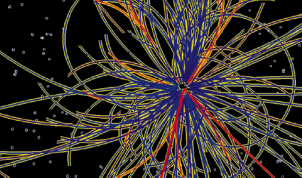Physicists from the Karlsruhe Institute of Technology (KIT), the RWTH Aachen University, and the Humboldt University in Berlin, together with DESY (the German Electron Synchotron) in Zeuthen, are attempting to rewrite fundamental laws of nature through extremely precise calculations. Toward this end, they joined forces four years ago to form the collaborative research project Tranregio 9 (SFB TR9) entitled “Computational Particle Physics”.
 "Every physical theory is provisional,” says Professor Johann Kühn of the Institute for Theoretical Physics at KIT. “Our conception of the smallest particles and the forces acting between them—the Standard Model—has some loose ends,” stresses the spokesperson for SFB TR9. This model cannot describe the conditions immediately after the Big Bang, nor can it explain why, practically speaking, only matter—and not antimatter—exists in the universe today. “With our calculations, we aim to make precise predictions for experiments at the new particle accelerators.” This should allow for the smallest deviations from the Standard Model to be found, which could in turn pave the way for a comprehensive theory. This is similar to how the precise determination of the positions of stars during a solar eclipse in the year 1919 demonstrated that the sun deflects starlight ever so slightly, which proved Einstein’s theory of relativity. Kühn expects that physicists will be looking beyond the borders of the Standard Model within the next five years.
"Every physical theory is provisional,” says Professor Johann Kühn of the Institute for Theoretical Physics at KIT. “Our conception of the smallest particles and the forces acting between them—the Standard Model—has some loose ends,” stresses the spokesperson for SFB TR9. This model cannot describe the conditions immediately after the Big Bang, nor can it explain why, practically speaking, only matter—and not antimatter—exists in the universe today. “With our calculations, we aim to make precise predictions for experiments at the new particle accelerators.” This should allow for the smallest deviations from the Standard Model to be found, which could in turn pave the way for a comprehensive theory. This is similar to how the precise determination of the positions of stars during a solar eclipse in the year 1919 demonstrated that the sun deflects starlight ever so slightly, which proved Einstein’s theory of relativity. Kühn expects that physicists will be looking beyond the borders of the Standard Model within the next five years.
To most people, Einstein’s formulas seem extraordinarily complicated. Yet today, theoretical physicists are working with much more complex equations—equations that pose difficulties even for computers. With the aid of parallel computers and programmes that they themselves have developed, the researchers of SFB TR9 have brought the Standard Model equations under control. The main focus of the Karlsruhe physicists are the algebraic calculations of the forces that act between elementary particles, while researchers in Berlin simulate the movements of these particles, and researchers in Aachen focus on the transformations of quarks, which are the building blocks of atomic nuclei. This theoretical work is “absolutely necessary” in order to interpret the measurements at the new particle accelerators, says Kühn.
Further Information: SFB/TR 9
